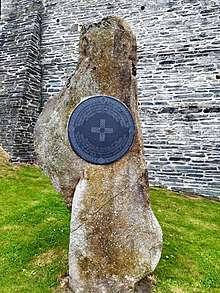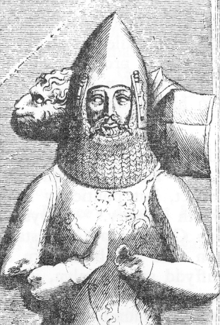1176 Cardigan eisteddfod
The 1176 Cardigan eisteddfod, as it is commonly described, was a cultural tournament involving bards and musicians, held in the grounds of Cardigan Castle, Cardigan, West Wales, by the Lord Rhys ap Gruffydd. Though the term 'Eisteddfodd' was not commonly used until several centuries later, the 1176 gathering is commonly claimed to be the earliest recorded forerunner of the modern national eisteddfod event.[1][2]

Background

Rhys ap Gruffydd became the ruler uniting the whole of Deheubarth, covering southwest Wales, in 1155. This had followed years of battles with the English King Henry II. Rhys was made Lord of Ystrad Tywi or, commonly, the Lord Rhys. There followed a period of relative peace and security.[1] In the early 1170s Henry II sought friendship with Rhys and confirmed his leadership of Deheubarth.[3] In 1171 Rhys rebuilt Cardigan Castle in stone, as a political and military statement, making it his chief residence.[4]
Welsh princes commonly patronised professional bards at the time, who in return wrote poetry praising their sponsors.[1][5]
The gathering at Cardigan Castle in 1176 is recorded in the medieval chronicle Brut y Tywysogion.[2]
The next eisteddfod in Wales of any certainty took place circa 1451 in Carmarthen.[2][6]
Description
According to Brut y Tywysogion, Lord Rhys announced the event a year in advance, "throughout Wales, England, Scotland, Ireland and the other islands", which suggests the event was on an unprecedented scale.[2] Participants came from as far away as Ireland and France. It was held at Cardigan Castle over Christmas of 1176. Cardigan Castle was newly restored in stone and, by holding a tournament here rather than at the traditional base of Deheubarth at Dinefwr, Lord Rhys was making a statement to the old Norman and Welsh rulers.[1]
According to the 1770 'History of Wales' "a great feast" was held and "many hundreds of English, Normans, and others coming to Aberteifi [Cardigan], were very honourably received, and courteously entertained by Prince Rhys ...Rhys called all the bards or poets throughout all Wales to come thither ...the bards being seated, they were to answer each other in rhyme."[7] Rhys awarded two chairs as prizes, one for the winner of the poetry competition and the other for music. The poetry chair went to a bard from Gwynedd, while the music prize went to the son of Eilon the Crythwr, a member of Rhys's court.[1] Chairs were a valuable asset, normally reserved for people of high status.[8]
It has been conjectured that the idea for a cultural festival of music and poetry at Cardigan may have originated from a similar festival in France known as The Puy. Rhys may have known about the tradition via his connections with the Norman French, or from soldiers returning from the continent.[9]
Legacy
The next recorded eisteddfods were held in Carmarthen between 1451 and 1453, by the powerful nobleman of the area, Gruffudd ap Nicholas. He wanted to emulate the Lord Rhys and, probably as a bard himself, wanted to strengthen the bardic tradition.[5] A 'Cadair Arian' (Silver Chair) was awarded as a prize, to a bard from Flintshire.[5]
At the next recorded eisteddfods, in the 16th century, chairs were again awarded as prizes. The first chair made for the modern form of Eisteddfod was at the Carmarthen event of 1819. They became regular prizes after the National Eisteddfod was introduced in the 1860s.[8] In 2015 a 9-foot (2.7 m) high Eisteddfod chair was created and installed at the top of Cardigan Castle's East Tower, as a centrepiece of an exhibition about the Wales Eisteddfod. The chair incorporated interpretative details that would have been important to the Lord Rhys, including a carved lion's head and two bronze horses.[10]
The modern restaurant at Cardigan Castle is named "1176" in reference to Lord Rhys's gathering.[11]
A novel about the 1176 event, entitled Song Castle by Luke Waterson, was published in 2018. The book imagined what the festival and the journeys made by its participants were like.[12]
References
- Phil Carradice (22 December 2010). "The first eisteddfod – Christmas 1176" (blog). BBC News. Retrieved 4 February 2019.
- John T. Koch, ed. (2006), Celtic Culture: A Historical Encyclopedia, I A-Celti, ABC CLIO, pp. 664–665, ISBN 1-85109-440-7
- Professor Thomas Jones Pierce. "RHYS ap GRUFFYDD (1132–1197), lord of Deheubarth, known in history as 'Yr Arglwydd Rhys' ('The lord Rhys')". Dictionary of Welsh Biography. Retrieved 7 February 2019.
- "Medieval legacy is there to be enjoyed". Wales Online. 21 March 2013. Retrieved 7 February 2019.
- Edwards, Hywel Teifi (2016), The Eisteddfod, University of Wales Press, pp. 10–11, ISBN 978-1-78316-914-6
- "Cardigan Castle chapter closes with death of last private owner". Tivy-side Advertiser. 13 February 2009. Retrieved 4 February 2019.
- Francis Grose (1778), The Antiquities of England and Wales, London: Hooper & Wigstead, pp. 35–36
- "Long history of Eisteddfod chair". BBC News. 16 October 2009. Retrieved 9 February 2019.
- "Eisteddfod may have sprung from French idea". Wales Online. 9 February 2007. Retrieved 7 February 2019.
- Sion Morgan (18 March 2015). "Nine foot National Eisteddfod chair installed at the site of Wales' very first cultural festival". Wales Online. Retrieved 4 February 2019.
- Steve Adams (19 December 2016). "Staff at Cardigan Castle's 1176 restaurant round off hectic year with busy Christmas period". Tivy-side Advertiser. Retrieved 9 February 2019.
- Mike Lewis (18 March 2018). "Novel inspired by first eisteddfod and historic castle". Cambrian News. Retrieved 4 February 2019.